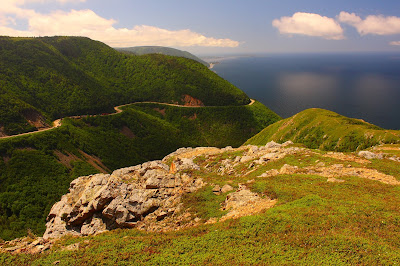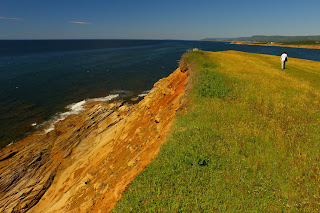 |
| As if it wasn't beautiful enough without the clouds' reflections . . . |
Yes, the beauty of Nova Scotia's most northeasterly island is stupendous. But it's also unsettling. At least it was unsettling to me now and again.
I know. You're looking at the photo above and thinking, "How could you look at this place and feel anything but thrilled and elated? How could you want to do anything except take in every gorgeous detail of it?"
But I was seeing more than panoramic ocean and mountain views from the roads and hiking trails. There was the fierce ruggedness of the rocky shelves at the bases of the cliffs. And there were the small, strong houses that stood alone on the barren hillsides and cliff-top flats surveying the ocean's uninterrupted expanse in every season and type of weather.
I wondered how much the undoubtedly self-sufficient inhabitants of those houses relished their isolation and how often they longed for the company and connection of neighbors. Did they come from families that had always lived by and with the sea? Had they ever yearned to live somewhere else, maybe even left for a while and come back? Did they think of the sea as primarily bountiful or treacherous--or was that the kind of question that only someone who'd never lived in such a place would ask? Maybe if I'd settled by the sea, I wouldn't be unsettled by it at all. Or maybe I'd just be much better at feeling unsettled.
For someone who'd come to Cape Breton for its natural attractions, I had a lot of questions about the lives of its people--and I kept having more. It made sense: for every book about the island's natural history in the gift shop of the Cape Breton Highlands National Park Visitor Information Centre,* there was another about the island's human history. Amidst the stories of Acadian, French, Scottish, and British settlement and displacement, of abandoned villages and islands, were numerous books about loss of life at sea: books about shipwrecks in routinely dangerous waters off the coast--we'd passed a place called "Wreck Cove"--and a whole section about Titanic passengers whose recovered bodies were brought to Halifax for burial.
 |
| White Point |
Five days later when Scott asked me if I wanted to return there, I said no. No matter how magnificent the spot was aesthetically, returning to it would have meant needing to feel again its eeriness and tragic loneliness. I wasn't up for that. The sea, I knew, would once again present itself as harmlessly, scenically sapphire blue. But I would know otherwise.
Over the following days, I began to suspect that I wasn't the only one daunted by the sea's seductive but absolute dominion. The Cape Breton 2018 calendars** on sale in the visitor center gift shop tried to offer an antidote to those narratives about nature's fierce power and humankind's sometimes innocent, sometimes arrogant miscalculations. Without exception, the photos for each month, even those that foregrounded nature, depicted more that was tamed and human than wild and unpeopled. Only one photo captured a rough sea. The vast was reigned in, trimmed to human scale.
In contrast to the bounded, managed sapphire seas the calendar featured, the ones we saw most days spread unimpeded from empty beaches and bases of cliffs toward the horizon. There, they became an elongated, diaphanous, almost turquoise smudge that ascended to and merged with the sky, then seemed to cross over into a place beyond our perceptions.
 Scott loved the vast endlessness and the expansive loneliness of this unbounded ocean--all the more because its smooth, glistening surface belied its hidden complexities and natural ferocity. Camera in hand, he wanted to capture its gorgeousness and force, its natural destructive power--which meant he wanted to stand as close as possible to the edge of anything near
it--mountain roadsides, seaside boulders--and especially cliffs. Scott doesn't take stupid risks, but I still felt relieved
every time I saw him step back or down from some natural vantage point
that had called to him.
Scott loved the vast endlessness and the expansive loneliness of this unbounded ocean--all the more because its smooth, glistening surface belied its hidden complexities and natural ferocity. Camera in hand, he wanted to capture its gorgeousness and force, its natural destructive power--which meant he wanted to stand as close as possible to the edge of anything near
it--mountain roadsides, seaside boulders--and especially cliffs. Scott doesn't take stupid risks, but I still felt relieved
every time I saw him step back or down from some natural vantage point
that had called to him. |
| Sunday Morning at the Margaree River |
Scott and I talked about my uneasiness before the vast, the powerful, the infinite. As one generally alert to and thankful for the holiness of Creation, I had thought I'd be fully caught up in the sacred aspects of Cape Breton's natural landscape. That's why my ambivalence bothered me. I didn't want to cower before the Divine beautiful. I didn't want to feel intimidated by its vastness and power. But it's hard to soar when you're sore afraid. When Scott reminded me that fear was traditionally understood as an aspect of awe, that helped. Creation is awesome, but the Lord giveth and the Lord taketh away: death and destruction are as natural as anything else, everywhere.
 |
| On the cliffs beyond the Calvin Church Cemetery |
 By the time we left Cape Breton, I was far more focused on the uplifting beauty of the land and the sea than on their rugged, indifferent might. I was also excited to begin to read Anne-Marie MacDonald's Fall on Your Knees, which I'd bought before our trip because it is set on Cape Breton. I had originally looked forward to knowing the towns and places MacDonald mentioned in the novel, but now I was hoping to gain a deeper understanding of how people live peacefully in naturally powerful places. So I just had to laugh when I read the book's first sentence: "They're all dead now" (9).****
By the time we left Cape Breton, I was far more focused on the uplifting beauty of the land and the sea than on their rugged, indifferent might. I was also excited to begin to read Anne-Marie MacDonald's Fall on Your Knees, which I'd bought before our trip because it is set on Cape Breton. I had originally looked forward to knowing the towns and places MacDonald mentioned in the novel, but now I was hoping to gain a deeper understanding of how people live peacefully in naturally powerful places. So I just had to laugh when I read the book's first sentence: "They're all dead now" (9).**** * There are two such visitor information centers in the park; the one with the larger gift store is located in Chéticamp.
** I'm not sure if it's a memorial for Cape Breton or all of Nova Scotia, based on the information I found on this web site: https://www.cbisland.com/things-to-do/white-point-hiking-trail/
*** Screen shot of back page of Warren Gordon's Cape Breton Island 2018 calendar as advertised on the Gordon Photographic web site (http://www.gordonphoto.com/): http://www.gordonphoto.com/shop/books-calendars/product/calendar-cape-breton-island-2018.html
**** MacDonald, A. (2002). Fall on your knees. New York: Simon & Schuster.


